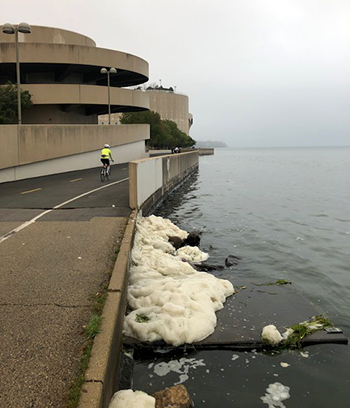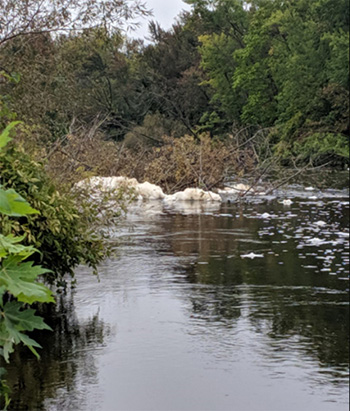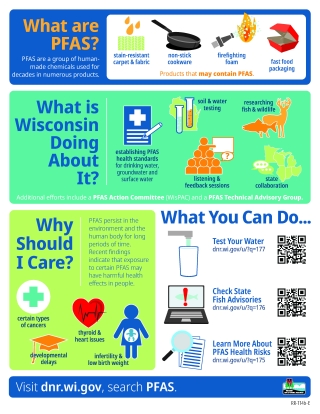PFAS and Foam on Waterways
Foam is a common occurrence on Wisconsin waterways and can often be observed floating on the surfaces of lakes and rivers. Surface water foam can form as a result of natural processes or from human-caused discharges such as runoff of contaminants into waterways.
People and pets should avoid foam on waterways because it can concentrate a variety of bacteria and chemical compounds.
What Causes Foam To Form
Two conditions must exist for foam to form on lakes and rivers.
- First, water must contain a substance that is capable of bubbling or foaming. This substance can be from natural sources (e.g., leaves decaying in water) or from human-made chemicals (e.g., PFAS or other chemicals).
- Second, there must be a mechanical action that introduces air into the substance and allows bubbles to form.
In rivers and lakes, foam-causing mechanical action can be wind, currents, water cascading over dams or even heavy rainfall. Any turbulent action in the water can create foam if the right substances are present. This process is familiar to us when we think about taking a bubble bath; a substance (i.e., soap) interacts with turbulent water flow and bubbles (or foam) form on the surface.
Foam can form in lakes in many different areas depending on wind and water currents and is often found collecting along shorelines, particularly after sustained winds out a single direction. Rivers and streams mix water naturally as they flow, which means foam is often observed floating in these waterways or collecting along shorelines or within eddies. Higher levels of agitation in a waterbody – for example, in whitewater rapids or at the base of a dam – often lead to significant collections of foam both at the agitation site and further downstream as the foam drifts. Surface water foam is most commonly found in spring (due to increased runoff) or fall (due to increased decomposition) but may be encountered during any time of year.
Natural Foams Vs. Synthetic Foams
Foams can develop in surface waters due to natural processes, chemical discharges (pollution) or a combination of both. In both cases, the color can vary from white to brown.
Natural foams develop when plants or other naturally occurring materials break down, and water becomes enriched with nutrients and then mixes with the air. Natural foam may appear white at first but will usually turn a tan to brownish color as it travels downstream and accumulates particulate matter and debris.
Synthetic foams can also develop as the result of water pollution. Spills, discharges or runoff that is contaminated with cleaning agents, nutrients, firefighting foam that contains per- and polyfluoroalkyl substances (PFAS), de-icing solution or other chemical contaminants can contribute to foaming events that are non-natural in origin.
Sometimes, both natural processes and pollution contribute to the formation of foam. Without a comprehensive understanding of the local environment, it is difficult to determine if any specific surface water foam event is a result of natural conditions, chemical pollution or both.
Health Concerns
Surface water can contain algae, viruses, bacteria, parasites, decaying organic matter and other contaminants that, if swallowed, can pose a health risk to people and pets. Surface water foam concentrates a variety of pathogens and synthetic compounds.
It is important to remember that regardless of whether foam is the result of natural causes, pollution or a combination of the two, it can present a human health risk. The Wisconsin Department of Health Services recommends that everyone - people, pets and, especially, young children - avoid surface water foams.
Surface water foam can become a health concern during hand-to-mouth activity when foam or the residue left behind on the skin is accidentally swallowed. In addition, certain pathogens and chemicals in foam might cause skin irritation or enter the body through an open wound. Therefore, wash skin that has touched surface water foam as soon as possible and always wash hands before preparing or eating food. Keep open wounds away from surface water and foam. If pets go in the water with foam, rinse them with fresh, clean water and do not let them lick foam from their fur.
PFAS Foam
Foam on waterways has recently garnered attention in some communities where there are known sources of PFAS contamination. PFAS are a group of human-made chemicals used for decades in numerous products, including non-stick cookware, fast food wrappers, stain-resistant sprays and certain types of firefighting foam. These contaminants have made their way into the environment in a variety of ways including spills of PFAS-containing materials, discharges of PFAS-containing wastewater to treatment plants and use of certain types of firefighting foams.
Where PFAS are found in surface water, the foam associated with the surface water contamination also often contains PFAS at much higher concentrations. It is impossible to determine whether foam contains PFAS just by looking at its color, shape or size. It is also difficult to determine how PFAS concentrations in the water contribute to PFAS concentrations in foam. As some compounds found in water may concentrate in foams, it is possible that surface water with lower concentrations of PFAS can produce foam with higher concentrations of PFAS.
For more information on PFAS and health, visit the Wisconsin Department of Health Services website.
Foam Reporting and Sampling
The DNR rarely samples surface water foam. Staff determines on a case-by-case basis whether a sighting may trigger surface water or other media sampling, based upon the likelihood of a significant upstream or nearby PFAS source that has yet not been investigated.
The DNR has conducted foam sampling at a limited number of locations, including the Peshtigo River and Starkweather Creek. The DNR also assisted a UW-Madison research study to better understand PFAS in surface water and foam by, when possible, collecting foam samples. This study showed that natural foams may contain higher levels of PFAS than the water the foam formed upon, and the presence of foam does not mean that water has high levels of PFAS.
Frequently Asked Questions
Should I report foam to the DNR?
No, you don’t need to report seeing foam to the DNR. Foam naturally forms on water where there is a combination of nutrients (e.g., fertilizer) or organic materials (e.g., decaying leaves) in the water and the water is mixed with air. This mixing can occur because of weather conditions, such as strong winds, or when water flows over rocky areas, dams or waterfalls. Bubbles form as the water mixes with air, which creates foam.
Will the DNR sample foam for PFAS?
The DNR is generally unable to collect foam or have it analyzed for PFAS. The conditions that allow for foam to form are often temporary. By the time staff are able to respond to foam sightings, the foam will likely have broken down and dispersed.
What should I do about foam along the shoreline of my property?
The DNR recommends avoiding contact with foam. The foam will naturally break down and dissolve back into the water. Foam can contain high levels of contaminants that may pose a health risk to humans and pets. If you touch foam, wash your skin with soap and clean water as soon as possible. Pets that touch foam should also be rinsed with clean water.




